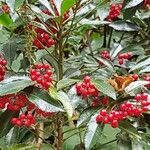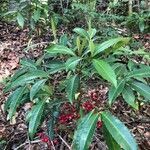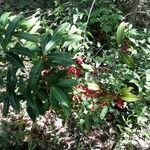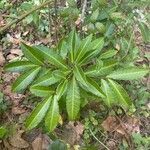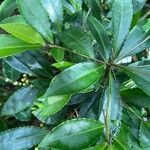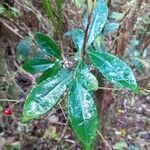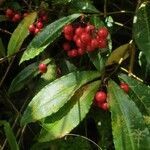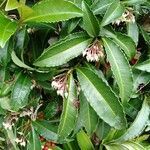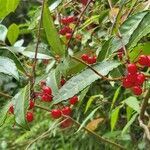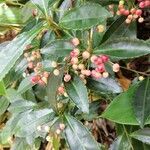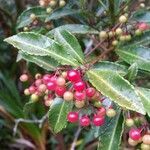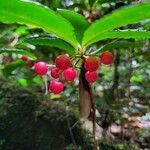Shrubs, not stoloniferous, 1-1.5(-3) m; branchlets minute-ly reddish glandular-papillate. Leaves: petiole 6-10 mm, glabrous; blade elliptic, narrowly lanceolate, or oblanceolate, 7-15 × 2-4 cm, margins crenulate or undulate, subrev-olute, (bearing large vascularized nodules), apex acute or acuminate, surfaces minutely reddish glandular-papillate. Inflorescences terminal, on specialized, 2-or 3-leaved lateral branches, umbels or cymes, 5-18+-flowered. Pedicels sometimes erect, 7-10 cm, minutely reddish glandular-papillate. Flowers: sepals (4-)5(-6), oblong-ovate, 1-1.5(-2.5) mm, margins entire, apex rounded or obtuse, glabrous; petals (4-)5(-6), white or rarely pinkish, ovate, 4-6 mm, margins entire, apex acute, punctate, glandular-papillose adaxially near base; stamens shorter than petals; anthers triangular-lanceolate, apex acute, punctate abaxially; ovary glabrous; ovules ca. 5, uniseriate. Drupes red, 6-8 mm diam., punctate.
Shrub 1–3 m high. Leaves spirally arranged; petiole (3–) 6–10 mm long; lamina elliptic-lanceolate, oblanceolate, rarely ovate, 5–20 cm long, (1.5–) 2–4 cm wide, coriaceous, margin crenate, undulate and revolute, nodules or secretory trichomes prominent in the sinuses, glands globular and lineate, orange to black. Inflorescence umbelliform, to 4 cm long and 10 cm wide, 6–14 flowers per umbellate cluster; pedicels 6–10 mm long, glands both dark lineate and globular, chiefly orange-coloured. Flowers 5-merous, 6–7 mm long; calyx to 2 mm long, lobes to 1.5 mm wide; corolla rotate, white, tube c. 0.2 mm, lobes to 6 mm long, c. 4 mm wide; stamens with anthers to 3 mm long, c. 1.5 mm wide, dehiscence initially by small apical pores then longitudinal; ovary conical, c. 1 × 1 mm; style c. 2 mm long; ovules uniseriate, 3–5. Fruit globular, (5–) 6–8 mm diam., red. Seed depressed-globular, c. 5 × 5–6 mm.
An evergreen shrub. It grows 1 m high and spreads 1 m wide. The stems are erect and branching. The leaves are shiny green. They have wavy edges. The leaves are arranged in rings around the stem. The flowers are white or pink. They have a scent. The fruit are bright red berries.
